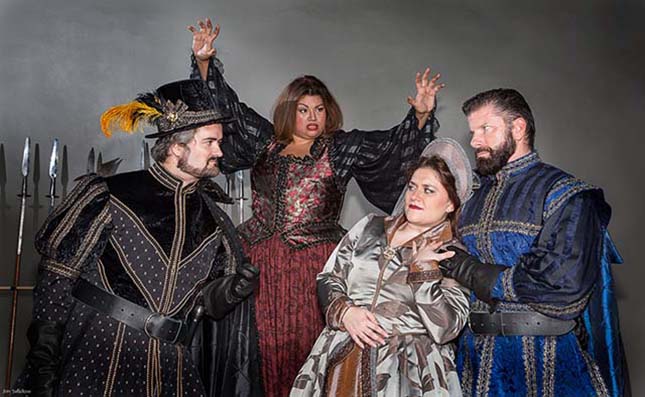
IL TROVATORE. Opera by Giuseppe Verdi, libretto by Salvatore Cammarano. Cast: Michael Morrow (Manrico); Alexandra Batsios (Leonora); Claudia Chapa (Azucena); Christopher Clayton (Count di Luna). Stage Director: Karl W. Hesser; Costume designer: Glenn Breed; Conductor and executive director: Mark Sforzini. Produced by St. Petersburg Opera.
If you have never seen a Verdi opera before, you should see Il Trovatore. Of course there’s a chance you may get addicted and have to also see La Traviata, Otello, and Rigoletto, but that’s a nice price to pay. I couldn’t for the life of me recommend the best, but this one by the St. Petersburg Opera is a good place to start.
All the elements were there: splendid acting, breakneck pacing (for the most part), well-constructed period set, and above all, wondrous singing by all the actors, including the choruses. “Examples, please!” you say. Calm down and give me a minute.
George Bernard Shaw said “Opera is when a tenor and soprano want to make love, but are prevented from doing so by a baritone.” That’s the case here: Manrico is a gypsy who loves Leonora but Count di Luna also loves her and does all he can to interfere. There’s an outrageously implausible plot about children who got mixed up and misread gypsy motives, but I won’t get into that. There are enough plot summaries on the internet to satisfy your curiosity. It is so popular it has been satirized in both the nineteenth century and the twentieth (Gilbert and Sullivan in HMS Pinafore [1878] and The Marx Brothers in A Night at the Opera [1935]). Here are some notable scenes.
Verdi gets down to business early, with “Stride la vampa,” one of the most notable solos of the evening. As the gypsy Azucena, Claudia Chapa, festooned with a mane of wild gray hair, tells the story of her mother, accused of being a sorceress, condemned to death and burned alive. Because mezzo-soprano Chapa dips into lower registers and dramatically moves about, her rising anger was palpable. I could feel she was obsessed with avenging her mother.
As Lenora, Alexandra Batsios provides showstopping music in the famous “Miserere.” This aria requires such poise and technical facility, plus the right voice profile. It’s not about volume; it’s about having a voice with a strong identifiable sound, as Batsios has all the way through. The piece is a tempo di mezzo, probably the most famous in Italian opera. It combines three contrasting musical ideas: the solemn “Miserere” itself, Lenora’s fragmented response, and Manrico’s offstage farewell, sung simply but affectingly by Michael Morrow. (It is reminiscent of his lyrical canzone from Part 1, which I always find too muted on recordings.) On top of that, Mark Sforzini’s well-honed & snappy orchestra plays an insistent (and scary) “death rhythm.” Plus, and this is a big one, Leonora is the only one on stage at the time. It’s all up to her.
From Part 3, “Di quella pira” is another great moment. (It was the first opera aria I heard at fifteen, and because I couldn’t stop talking about it, my grandfather bequeathed me his classical music collection.) It’s Manrico’s song about going out to avenge his mother. A stirring cabaletta with chorus, high C’s, swords flashing and vengeance raining down, it’s the quintessential call to arms. Morrow carries the moment forward, never flagging for an instant.
In Part 4, the Count suddenly states his religious preference: “The only god I know is vengeance.” Ever the master, Verdi gives those lines their own melodic stamp, and Christopher Clayton delivers them succinctly and passionately. At first hearing, you expect them to develop into a longer piece, like Iago’s “Credo in un Dio crudel” from Otello, but Verdi abandons this gem after a few seconds.
The pacing slows in Part 4’s prison scene between Manrico and Azucena, probably as contrast to the intense emotionalism that follows, as Leonora reveals her machinations to free Manrico. The tragic climax occurs shortly afterward, and the crowd departs, not just satisfied but properly dazzled. The only way the company can top this performance is to release it on DVD.
